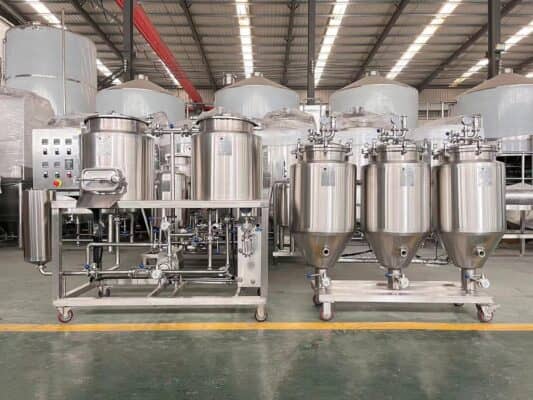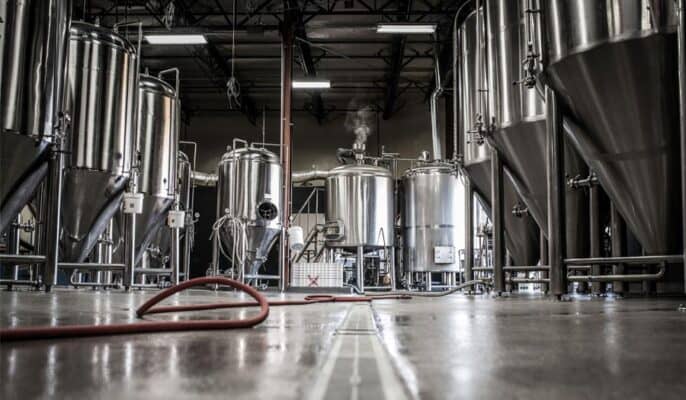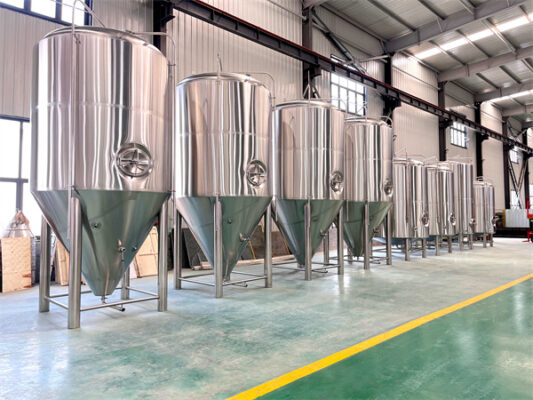A mini brewery, also known as a craft or microbrewery, produces beer on a small, independent scale compared to large commercial breweries. Setting up a successful mini brewery requires careful planning and investment in quality equipment. This comprehensive guide covers everything you need to know about mini brewery equipment.
Přehled o Zařízení minipivovaru
When starting a mini brewery, the key equipment categories to invest in are:
Systém vaření – The tanks and vessels used to mash, lauter, boil, ferment, condition, and serve the beer. This includes the mash tun, lauter tun, brew kettle, fermenters, brite tanks, and serving tanks.
Řízení teploty – Heating and cooling systems to precisely control temperatures during mashing, fermentation and storage. This includes hot liquor tanks, heat exchangers, cooling jackets, and glycol chillers.
Potrubí – Plumbing between vessels for transferring liquids, recirculating wort, cleaning and sanitizing. This includes hoses, pumps, valves, fittings and controls.
Čištění a sanitace – Equipment for safely and effectively cleaning and sanitizing all parts that contact beer. This includes chemical storage tanks, mixers, spray balls, CIP systems, and more.
Process Control & Automation – Instruments, sensors, meters and computer hardware/software to monitor and automate the brewing process. This includes PLCs, HMI displays, sensors, actuators, batch controllers and data historians.
Balicí zařízení – Machines to fill, seal, label and package beer into kegs, cans, bottles or other containers. This includes labelers, fillers, cappers, keg washers and canning/bottling lines.
Doplňkové vybavení – Other critical equipment like forklifts, grain handling systems, water treatment, boiler, air compressor, cold storage, wastewater system, and more.
Properly designed and sized brewing equipment tailored to your production goals and business plan is key to maximizing quality, efficiency and profitability.
Types of Mini Brewery Equipment
The table below summarizes the major equipment types needed for a mini brewery operation:
| Vybavení | Popis |
|---|---|
| Mash Tun | Stainless steel insulated vessel where milled grain is steeped in hot water to extract sugars, starches, colors and flavors. Essential for all-grain brewing. |
| Lauter Tun | Separates sweet liquid wort from spent grain after mashing. Usually combined with mash tun into a single mash/lauter tun. |
| Varná konvice | Boils the wort to extract hop flavors, sterilize and concentrate before fermentation. Often direct fire or steam heated. |
| Hot Liquor Tank | Holds hot water for mashing and sparging. Usually steam-heated or electric. |
| Výměník tepla | Rapidly cools hot wort after the boil and before fermentation by heat exchange with cold water. |
| Kvasné nádoby | Food-grade stainless steel or plastic vessels where yeast ferments sugars into alcohol and CO2. Closed, sanitary environment needed. |
| Nádrž Brite Tank | Also called a conditioning tank or serving vessel. Allows yeast sedimentation and carbonation before packaging. |
| Glykolový chladič | Uses food-grade propylene glycol to cool fermenters, brite tanks, and other vessels to precise temps. |
| Piping & Pumps | Interconnections for transferring liquids between vessels. Hoses, rigid piping, centrifugal & positive displacement pumps. |
| Sanitation Equipment | Storage tanks, mixing stations, spray balls, probes, fittings, hoses, circulation pumps and CIP systems for automated cleaning and sanitizing. |
| Systém řízení procesů | Automated system including PLC hardware, SCADA/HMI software, sensors, valves, switches, and actuators to monitor and control the brewing process. |
| Packaging Line | Fillers, cappers, labelers for kegs, cans, bottles synchronized by conveyors and controls. Options like depalletizers, palletizers, date coders. |
| Systém manipulace s obilím | Conveyors, bucket elevators and augers to move grain. Scales for weighing and tracking. Mills to crush malt. Dust control. |
| Kotel | Provides steam for direct heating kettles and vessels. May also heat hot liquor tank. Natural gas or biomass-fired. |
| Air Compressor | Supplies compressed air for automation systems, packaging, keg/bottle filling heads equipment actuation. |
| Glycol & Water Systems | Includes recirculating chillers, pumps, storage tanks and heat rejection systems for liquid temperature control. |
| Forklift | Used to move heavy grain sacks, pallets of packaged beer, kegs and supplies around brewery. Electric lift truck recommended for indoor use. |
| Wastewater Equipment | Tanks, screens, clarifier, filters, pH adjustment system, sludge dewatering to properly treat and discharge brewery wastewater. |
| Cold Storage | Insulated, cooled rooms for yeast, hops, chemicals and finished beer inventory storage. Conditions ideal for brewing and packaging. |
This covers the critical systems and equipment involved in beer production. Sizing each component correctly based on your business requirements is vital to avoid bottlenecks.

Zařízení minipivovaru by Capacity
A mini brewery’s production capacity determines equipment sizing and layout. The table below provides a guideline on equipment requirements based on annual barrelage capacity:
| Annual Barrel Production | 1-500 BBLs | 500-1500 BBLs | 1500-5000BBLs |
|---|---|---|---|
| Pivovar | 1-3 BBL System | 5-7 BBL System | 10-15 BBL System |
| Kvašení | Up to 12 FV Tanks | Up to 20 FV Tanks | Up to 60 FV Tanks |
| Nádrže Brite | 1-3 Tanks | 3-5 Tanks | 5-10 Tanks |
| Glycol Chiller Capacity | 5-10 Ton | 10-20 Ton | 20-40 Ton |
| Balení | Manual / Semi-Auto | Semi / Fully Auto | Fully Auto Bottling & Canning |
| Řízení procesu | Základní | Expanding | Pokročilá automatizace |
| Doplňkové vybavení | Shared Multi-Use | Dedicated Systems | Specialized Equipment |
FV = Fermentation Vessel
The number, size and level of automation for each equipment type scales with production goals. Investing in more capacity than required adds unnecessary expense. Begin small and expand incrementally.
Brewery Design Layout
Good brewery design balances functionality, efficiency and cost:
Funkčnost – Meets production requirements with room for controlled growth
Účinnost – Optimized material and personnel workflows to maximize output
Náklady – Matches capital expense to business model and production capacity
Use these design principles as a guide when developing your brewhouse layout:
Gravity Flow – Stage equipment to utilize gravity transferring liquids downhill from grain intake to fermentation cellar to packaging to shipping areas. This avoids unnecessary pumping and pipework.
Spacing – Allow ample space between vessels and systems for material handling equipment like pallet jacks and forklifts as well as maintenance access. This improves safety and reduces labor.
Rozšiřitelnost – Orient equipment to allow for expansion in stages without reconfiguring existing infrastructure. This reduces disruption and cost when growing.
Zoning – Group equipment and production steps into Hot Side (brewhouse), Cool Side (fermentation, storage), Packaging zones. This compartmentalizes processes, utilities usage and waste streams.
Komunální služby – Cluster equipment with similar utility requirements like steam, glycol, electricity, water, wastewater, and compressed air to simplify distribution infrastructure. This improves efficiency and reduces installation expense.
An experienced brewery engineering consultant understands optimal configurations tailored to your site, production goals and budget.
Customization of Mini Brewery Equipment
While much brewery equipment is based on standard designs, custom fabrication provides advantages:
Optimized Dimensions – Vessels and systems sized exactly to your space constraints, batch sizes and growth plans avoid over or under buying capacity.
Výběr materiálu – Choose vessel materials like stainless steel grade and finish quality based on your level of sanitation requirements, chemical compatibility needs and budget.
Added Features – Functionality like automated valves, sight glasses, enhanced controls, lifting lugs and custom ports can be designed in from start versus added later.
Matched Modules – Fabricating brewhouse vessels, pipework, controls and utilities as integrated modules that line up and connect quickly reduces installation time and cost.
Relocation – Custom equipment can be designed for disassembly and relocation if needed as your business expands to larger production facilities.
Evaluate whether custom or standardized equipment best balances functionality, efficiency and lifetime value for your specific mini brewery.
Suppliers of Mini Brewery Equipment
Many equipment manufacturers and brewery engineering firms offer mini brewery equipment in standardized or custom configurations. When selecting a supplier, consider these criteria:
Supplier Comparison Chart
| Parametry | Kritéria hodnocení |
|---|---|
| Technika | Quality of vessels, automation systems, packaging equipment |
| Přizpůsobení | Ability to customize equipment to your specifications |
| Designové služby | Offer brewhouse design, layout and integration services |
| Zkušenosti | Years of experience building small brewhouses |
| Reference | Positive reviews from existing microbrewery clients |
| Předběžné časy | Quick fabrication and delivery turnaround |
| Záruky | Equipment defects and performance warranties |
| After Sales Service | Installation support, maintenance contracts, spare parts |
| Certifikace | ISBT, ASME pressure vessel certification |
| Umístění | Close proximity lowers shipping costs |
| Ceny | Competitively priced within your capital expenditure budget |
Research multiple vendors using this scorecard approach to find the best match for your specific needs and constraints.

Price Range for Mini Brewery Equipment
The total capital investment for mini brewery equipment can range widely:
Small 1-7 BBL Brewhouses
- Total Equipment Cost: $150,000 to $500,000
- Cost per BBL: $25,000 to $100,000
Medium 10-30 BBL Systems
- Total Equipment Cost: $500,000 to $2 million
- Cost per BBL: $15,000 to $50,000
Large 30-60 BBL Facilities
- Total Equipment Cost: $2 million to $5 million
- Cost per BBL: $10,000 to $20,000
Equipment costs scale with capacity but decline on a cost per BBL basis. Small start-up systems under 7 BBL generally have the highest capital outlay per barrel of capacity.
Installation of Zařízení minipivovaru
Proper installation of mini brewery equipment requires planning and skilled tradespeople:
| Úkol | Podrobnosti na |
|---|---|
| Příprava webu | Floor sloping, trenching, drainage, utilities, waste water in place before delivery |
| Receiving | Unload with lift truck, inspect, stage equipment near final position |
| Polohování | Slide vessels and systems into final position aligned to pipe connections |
| Utility Hookups | Steam, water, drains. glycol, CO2, compressed air lines connected |
| Potrubí | Stainless steel pipes, valves, hoses for transfers between vessels using unions/flanges |
| Řízení procesu | Instrumentation wiring – sensors, switches, automation panels wired into control circuits |
| Insulation & Cladding | Apply foam insulation and metal cladding to tanks |
| Integrated Testing | Individual vessels & systems testing followed by total brewhouse testing for leaks, alignment issues |
| Uvedení do provozu | Test brewing runs to verify recipes, production rates, quality, DO sensors tuning |
Hiring an engineering firm or experienced brewery contractor is advised to manage installations for optimal safety, efficiency and performance.
Operation of Mini Brewery Equipment
Once installed and commissioned, best practices for operating mini brewery equipment include:
Monitorování – Continuously watch brewery process trends and key parameters on directories like mash pH, tank levels and temperatures.
Alerting – Configure warning and alarm thresholds on process control systems to notify of out of spec conditions.
Logging – Collect and archive records of each batch including bills of materials, lab results and production logs for tracing and analysis.
Údržba – Perform regular inspections, scheduled preventive maintenance and calibrations on all equipment according to manufacturer guidelines.
Čištění – Thoroughly clean and sanitize vessels after each use to prevent microbial contamination using appropriate chemicals and procedures.
Testování – Take wort/beer samples during key processing stages and lab test for gravities, alcohol, pH, bitterness and microbial stability.
Following excellent operating practices ensures long equipment lifetime, consistent quality and optimized production yield over years of brewhouse operation.
Maintenance of Mini Brewery Equipment
Preventive maintenance keeps mini brewery equipment in peak working order:
| Úkol | Frekvence |
|---|---|
| Inspekce | Daily walkthroughs check for leaks, unusual noise/vibration, errors |
| Sensor Calibration | Monthly check/recalibrate temperature, pressure, flow sensors |
| Valve Exercising | Quarterly cycle valves and actuators fully open and closed |
| Seal Inspection | Annual check pump seals, valve stem packing, gaskets for wear, leaks |
| Vessel Inspection | Annual open manways and sight glasses to inspect vessel interiors |
| Pipe/Hose Inspection | Annual check pipework and transfer hoses for cracks or damage |
| System Testing | Annual simulated brew runs and control function validation |
| Preventive Rebuilds | Periodic rebuild pumps, replace worn parts ahead of failure |
Documenting completion of maintenance tasks by date and technician supports quality programs like ISO certification. Tracking equipment service history also helps diagnose issues.
Výběr správného Zařízení minipivovaru Dodavatel
Selecting competent, reputable equipment vendors ensures your mini brewery project success:
| Parametr | Kritéria hodnocení |
|---|---|
| Design Experience | Has portfolio of small brewhouse projects with proven layouts |
| Fabrication Expertise | Specializes in brewery vessels, pipework and controls |
| Partners | Has qualified third party vendors to provide ancillary equipment |
| Testing Capability | Can perform integrated factory testing of modules before shipment |
| Program Management | Will professionally manage equipment sourcing, fabrication, shipping, installation and commissioning |
| Dokumentace | Provides equipment manuals, drawings, warranties and training |
| Budget Alignment | Works within capital expenditure budget and cash flow constraints |
| Local Support | Available for supervision of installation, testing and training |
| Průběžná podpora | Provides maintenance contracts and readily stocks replacement parts |
Taking time to thoroughly qualify suppliers reduces project delays, additional costs and long term equipment headaches.

Comparing Pros and Cons of Mini Brewery Equipment
Each type of mini brewery system has intrinsic benefits as well as practical limitations to consider:
Manual Equipment
Pros:
- Lower upfront capital investment
- Simple tanks and manual valves are inexpensive and easy to maintain
Cons: – Labor intensive material handling
– Less consistency batch to batch – Limited scalability before quality is impacted
Semi-Automated Systems
Pros:
- Adds pumps, sensors and controls for motorized automation
- Saves labor over manual systems
- Maintains hands-on control for small batches
Cons:
– Eventually becomes a bottleneck limiting growth. – Mix of manual and automated steps can reduce consistency
Fully Automated Brewhouses
Pros:
- Highest consistency and repeatability between batches
- Advanced automation maximizes production capacity
- Less manual labor results in better safety and lower OpEx
Cons:
– Complex programming and networking have higher maintenance – Requires higher technical skill to troubleshoot issues – Highest upfront equipment capital investment
Determine the level of automation that optimally balances labor savings, total cost of ownership and product quality for projected production volumes.
ČASTO KLADENÉ DOTAZY
What is mini brewery equipment?
Mini brewery equipment refers to a compact and smaller-scale brewing setup designed for craft or homebrewing purposes. It includes various components like kettles, fermenters, pumps, and more, which allow individuals to produce smaller batches of beer compared to commercial breweries.
What are the essential components of mini brewery equipment?
The essential components typically include a mash tun, boil kettle, fermenters, temperature control system, pumps, hoses, and a cleaning system. Some setups may also have additional features like a wort chiller, grain mill, and kegging equipment.
What is the capacity of mini brewery equipment?
Mini brewery equipment can vary in capacity, but it generally produces batches ranging from 1 to 10 barrels (31 to 310 gallons). The specific capacity depends on the size and configuration of the equipment.
Is mini brewery equipment suitable for homebrewing?
Yes, mini brewery equipment is ideal for homebrewers who want to produce beer in smaller quantities. It allows for greater control over the brewing process and experimentation with different beer styles.
What types of beer can I brew with mini brewery equipment?
You can brew a wide variety of beer styles with mini brewery equipment, including ales, lagers, stouts, IPAs, and more. The equipment’s flexibility allows you to experiment and create your own unique recipes.




